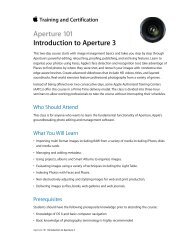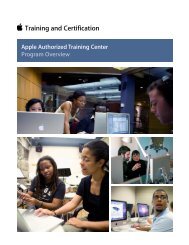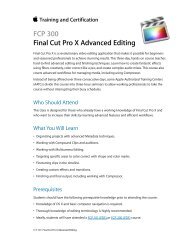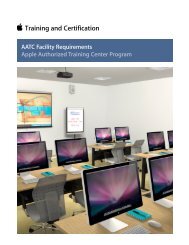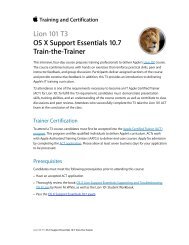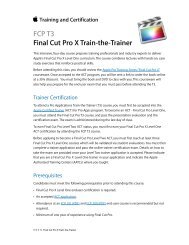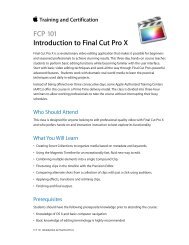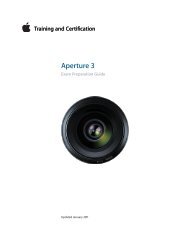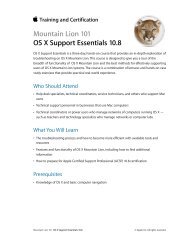OS X Support Essentials 10.8 - Training - Apple
OS X Support Essentials 10.8 - Training - Apple
OS X Support Essentials 10.8 - Training - Apple
You also want an ePaper? Increase the reach of your titles
YUMPU automatically turns print PDFs into web optimized ePapers that Google loves.
<strong>OS</strong> X <strong>Support</strong> <strong>Essentials</strong> <strong>10.8</strong> Exam Preparation Guide<br />
1. What are the primary system initialization stages in <strong>OS</strong> X?<br />
What are the visual and audible cues of these items?<br />
2. What does the firmware do? What is the Power-On Self-Test<br />
(P<strong>OS</strong>T)?<br />
3. What role does the system launchd process serve during<br />
system startup?<br />
4. Which items are automatically started by the system<br />
launchd during the system initialization process?<br />
5. What are the primary user session stages in <strong>OS</strong> X? What are<br />
the visual cues of these items?<br />
6. What is the difference between launch daemons, startup<br />
items, launch agents, and login items?<br />
7. What are Safe Sleep and Power Nap?<br />
8. What happens during user logout?<br />
9. What happens during system shutdown?<br />
Answers<br />
1. Each primary stage of system initialization can be indicated<br />
by the following: firmware, startup chime or bright flash of<br />
the power-on light followed by a light gray screen on the<br />
primary display; booter, a dark gray <strong>Apple</strong> logo on the<br />
primary display; kernel, a small dark gray spinning gear or<br />
spinning earth icon below the <strong>Apple</strong> logo; and system<br />
launchd, a white screen on all displays followed by the<br />
login screen.<br />
2. The firmware initializes the Mac computer’s hardware and<br />
locates the booter file on a system volume. The Power-On<br />
Self-Test (P<strong>OS</strong>T) checks for basic hardware functionality when<br />
the Mac powers on.<br />
3. The system launchd process is ultimately responsible for<br />
starting every system process. It also manages system<br />
initialization and starts the loginwindow process.<br />
4. During system initialization, the system launchd process<br />
automatically starts /System/ Library/LaunchDaemons, /<br />
Library/LaunchDaemons, /Library/StartupItems (via<br />
SystemStarter), and the /etc/rc.local UNIX script if it<br />
exists.<br />
5. Each primary stage of the user session can be indicated by<br />
the following: the loginwindow process displays the login<br />
screen; the user launchd process loads applications like the<br />
Finder after user authentication; and the user environment is<br />
active any time the user is logged into the system.<br />
48



